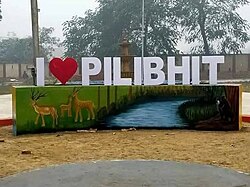Our website is made possible by displaying online advertisements to our visitors.
Please consider supporting us by disabling your ad blocker.
Pilibhit
Pilibhit | |
|---|---|
City | |
 I love Pilibhit sign at Nehru Park | |
| Coordinates: 28°37′36″N 79°48′21″E / 28.62667°N 79.80583°E | |
| Country | |
| State | Uttar Pradesh |
| Region | Rohilkhand |
| Division | Bareilly |
| District | Pilibhit |
| Ward | 27 |
| Settled | Late 15th century |
| Government | |
| • Body | Pilibhit Municipal Council |
| • Chairperson | Dr. Aashta Agarwal |
| • Member of Parliament, Lok Sabha | Jitin Prasada |
| • Member of State Legislative Assembly | Sanjay Singh Gangwar |
| Area | |
• Total | 26.22 km2 (10.12 sq mi) |
| Elevation | 172 m (564 ft) |
| Population (2023)[1] | |
• Total | 175,000 |
| • Density | 559/km2 (1,450/sq mi) |
| Demonym | Pilbhitian / Pilbhitiya / Pilibhitlite |
| Time zone | UTC+5:30 (IST) |
| PIN | 262001 |
| Telephone code | 05882 |
| ISO 3166 code | IN-UP-PB |
| Vehicle registration | UP-26 |
| Coastline | 0 kilometres (0 mi) |
| Sex ratio | 893 ♂/♀ |
| Literacy | 70.71% |
| Civic agency | Pilibhit Municipal Council |
| Distance from New Delhi | 274 kilometres (170 mi) NW (land) |
| Distance from Lucknow | 270 kilometres (170 mi) SE (land) |
| Governing body | State government Central government |
| Climate | HS-TH (Köppen) |
| Precipitation | 780 millimetres (31 in) |
| Avg. annual temperature | 25.5 °C (77.9 °F) |
| Avg. summer temperature | 36.8 °C (98.2 °F) |
| Avg. winter temperature | 14.5 °C (58.1 °F) |
| Website | www |
Pilibhit (Hindi pronunciation: [piːliːbʱiːt̪]) is a city and a municipal board in Pilibhit district in the northern Indian state of Uttar Pradesh. Pilibhit is the north-easternmost district of Bareilly division, situated in the Rohilkhand region of the sub-Himalayan Plateau belt next to foothills of Sivalik Range on the boundary of Nepal, known for the origin of river Gomati and one of the most forest-rich areas in North India. Pilibhit was also known as Bansuri Nagari – the land of flutes, for making and exporting roughly 95% of India's flutes.[2]
According to a report issued by the Government of India, Pilibhit is one of the Minority Concentrated Areas in India based on the 2001 census data on population, socio-economic indicators, and basic amenities indicators.[3] Though separated only by a short distance from the outer ranges of the Himalayas, Pilibhit consists entirely of a level plain, containing depressions but no hills and is intersected by several streams.[4] Pilibhit is one of the forest-rich areas of Uttar Pradesh. The almost 54 km-long Indo-Nepal international border makes Pilibhit a highly sensitive for security purposes.[5] According to an estimate by the Government of India, Pilibhit has 45.23% of its population living under the poverty line.[6] Increasing population and unemployment is a cause of worry in the area, and many non-governmental organizations (NGOs) and government-run organizations have initiated projects to provide employment, but human resources are yet to be exploited in full. The city came third-bottom in terms of hygiene and sanitation in a Government ranking list of 423 towns and cities in India.[7]
- ^ "Census of India Search details". censusindia.gov.in. Archived from the original on 24 April 2023. Retrieved 23 March 2023.
- ^ "Pilibhit as Bansuri Nagari". The Indian Express. 5 April 2009. Retrieved 24 January 2010.
- ^ "Minority Concentrated Districts". Government of India. Archived from the original on 28 October 2009. Retrieved 19 December 2007.
- ^ "The Physical Aspects". Government of India. Archived from the original on 19 February 2010. Retrieved 4 October 2009.
- ^ "Indo Nepal International Border". The Dainik Jagram, Hindi News Paper. Archived from the original on 18 July 2011. Retrieved 25 April 2009.
- ^ "Population under poverty line". A N Sinha Institute of Social Studies. Archived from the original on 16 December 2013. Retrieved 21 July 2007.
- ^ "Government of India, National Urban Sanitation Policy" (PDF). Archived (PDF) from the original on 21 July 2011. Retrieved 10 August 2010.
Previous Page Next Page



